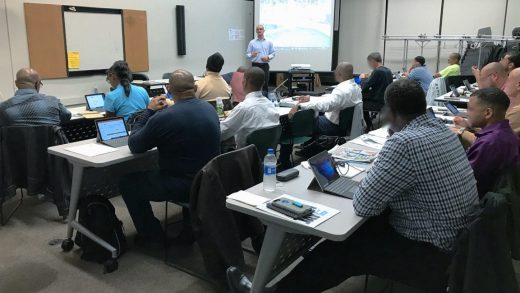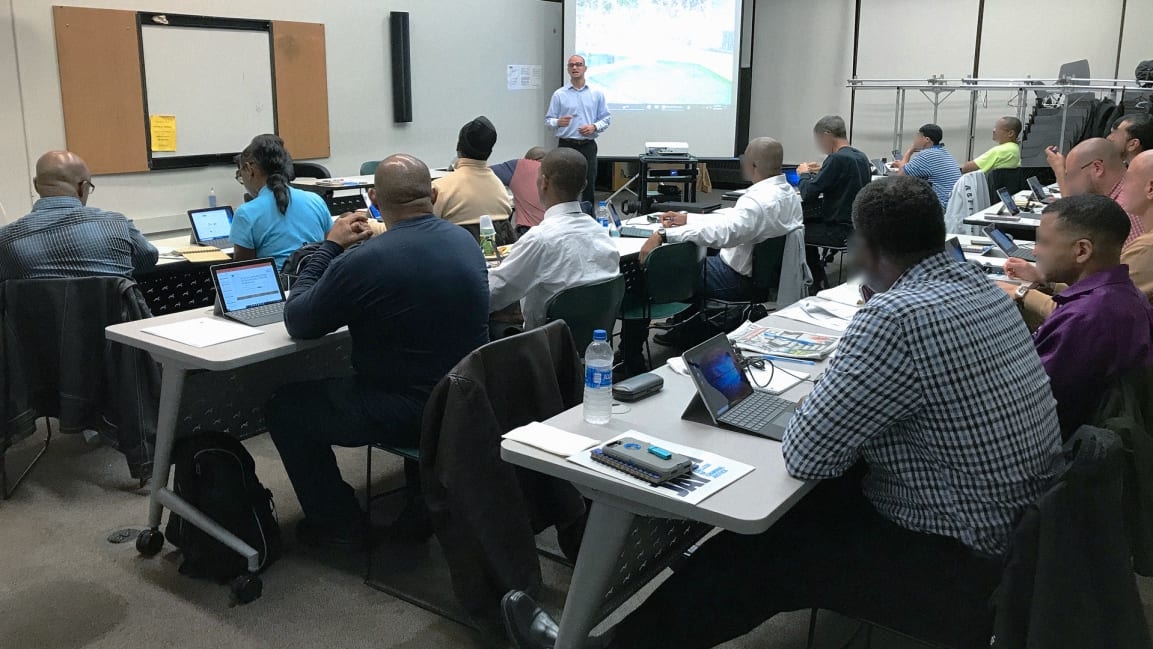This course helps former prisoners learn the tech they missed in jail
Since Wayne Booker returned home to New York City last year after a prison sentence of 28 years and nine months, he’s felt that “time is moving really fast.” He got involved with the Fortune Society, a nonprofit that works with families and people who have interacted with the justice system, and though he’s thriving in his work, the systems supporting it felt unfamiliar. “The world today revolves around technology,” Booker says, and that simply was not the case when his sentence began.
Elvin Garcia feels similarly. He’s been home for three years after a 32-year sentence and now works full-time as a family services counselor at the Fortune Society. What’s stood out to him is that now, “in society, if you don’t have basic computer skills, it’s more and more difficult to navigate.” For people returning home from prison, especially after long sentences, the task of catching up on the new technological developments that unfold every day is enormous but necessary.
Through a new course, though, both Booker and Garcia have begun to overcome that hurdle. Garcia’s learned to sync his email and social media accounts onto his mobile phone, which he now uses to manage his appointments for a job for which he’s frequently on the move. Booker has begun to investigate how social media can help him better communicate with the people he works with through the Fortune Society.
The course, Tech 101, is run through the Prisoner Reentry Institute (PRI) at the John Jay College of Criminal Justice in New York. When it was founded in 2005, PRI was designed to act as something of a bridge between the criminal justice system and other sectors, like employment and education, that have often been difficult for people leaving prison to access. PRI has helped coordinate college courses at state prisons and built out programs to help formerly incarcerated people enroll in educational courses.
Tech 101 covers vital basics that many people might take for granted. Over the course of 10 free sessions, Tech 101 assists people in setting up Google accounts and using the Microsoft Office suite. Students learn to set up LinkedIn accounts and other job-search profiles, and also get an overview of social media, including Facebook and Twitter. One of the key things Tech 101 helps people understand is the lack of privacy around social media, and how employers often scan profiles when making hiring decisions.
The course instructor, Albert Fermin, has taught technology inside prisons, and “teaches from the vantage point of really understanding the needs of people who were incarcerated for a long time and came out to face this new world of technology,” Sigman says. “Even if you don’t have a tech job, pretty much any job you want to get will require you to use email or Microsoft Office Suite, and you’re going to need to fill out online applications.”
PRI received funding from the New York City Mayor’s Office of Criminal Justice through its new Jails to Jobs initiative. The program is designed to improve and diversify the re-entry services available to people returning to New York City from jails and prisons. It’s part of a larger effort–which also includes closing the Rikers Island jail complex–on the part of Mayor Bill de Blasio to reduce incarceration in the city. Some of the initiative’s main projects, developed in partnership with nonprofits and other institutions, include offering everyone leaving city jails paid transitional employment and access to peer mentoring.
PRI wanted to address an even more basic need for people leaving jails and prisons. “What we heard from employers in the nonprofit and government sectors who want to hire people who were involved in the justice system is that a lot of times, there’s a gap in technology skills,” says Elena Sigman, director of collaborative learning at PRI.
People coming home from jail and prison already face significant hurdles to employment: Only 12% of employers say they will hire people with a criminal record. On top of that, “We found that the digital divide was really impeding people on their journey,” Sigman says. Tech 101 is designed to close that gap.
Even in the 13 years since PRI’s founding, technology, from email platforms to social media, has advanced dramatically. But PRI often works with people coming out of sentences longer than 25 years: The average sentence length for people in Tech 101 was 16 years. Only around 22% of people in prisons have used a computer, and even if they have, it may have been decades ago. Anne, one woman who participated in Tech 101 after a 32-year sentence, entered prison before computers became commercially available. Logging into one for the first time was an unfamiliar experience that the course helped Anne adjust to; she’s now begun to manage her budget on a computer.
Anne, who is turning 60, says that she took the course because she “refuses to be left behind.” Opportunities to learn the types of technology covered in Tech 101 are rare. Often, people pick up skills through school or the workplace, or the type of osmosis that occurs when you live in a world that’s infused with rapidly changing technology. Inside prison or jail, people are cut off from those resources.
There’s a special need for courses like Tech 101 now, and Sigman is hopeful that the successful first run of the program in New York will lead to replicas in other cities and counties. The partnership between educational institutions, the justice system and affiliated nonprofits, and the city, Sigman says, was crucial for getting this program off the ground, and that model could easily translate into other contexts.
Going forward, PRI expects to host three Tech 101 sessions in a year, and will continue to source feedback from students as it evolves (at the end of every session, PRI asks students to submit feedback through a Google form–“another opportunity to practice a tech skill,” Sigman says, and a way for the program leaders to learn what’s working). Students who participated in the pilot have hopes that the program will grow to offer more advanced classes. In the meantime, they anticipate staying involved as more students join. “Once you learn the basics, you really start feeling good about yourself, especially when you learn enough that you can start helping others,” Garcia says.
(17)



